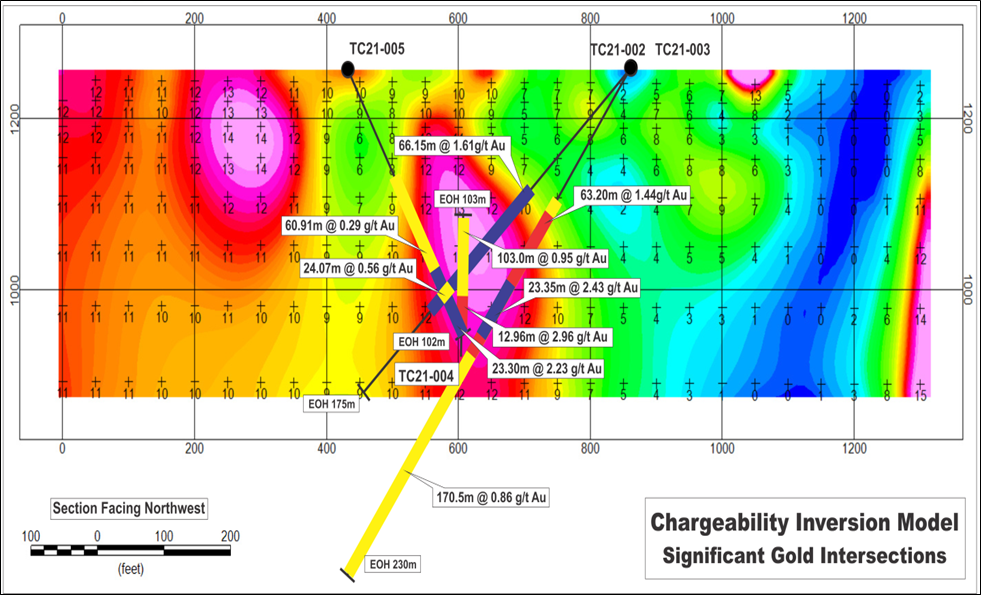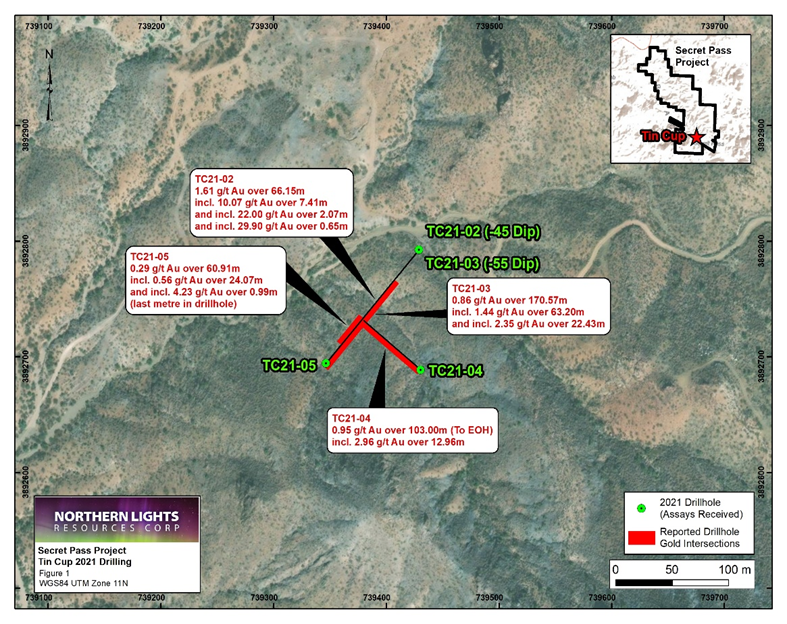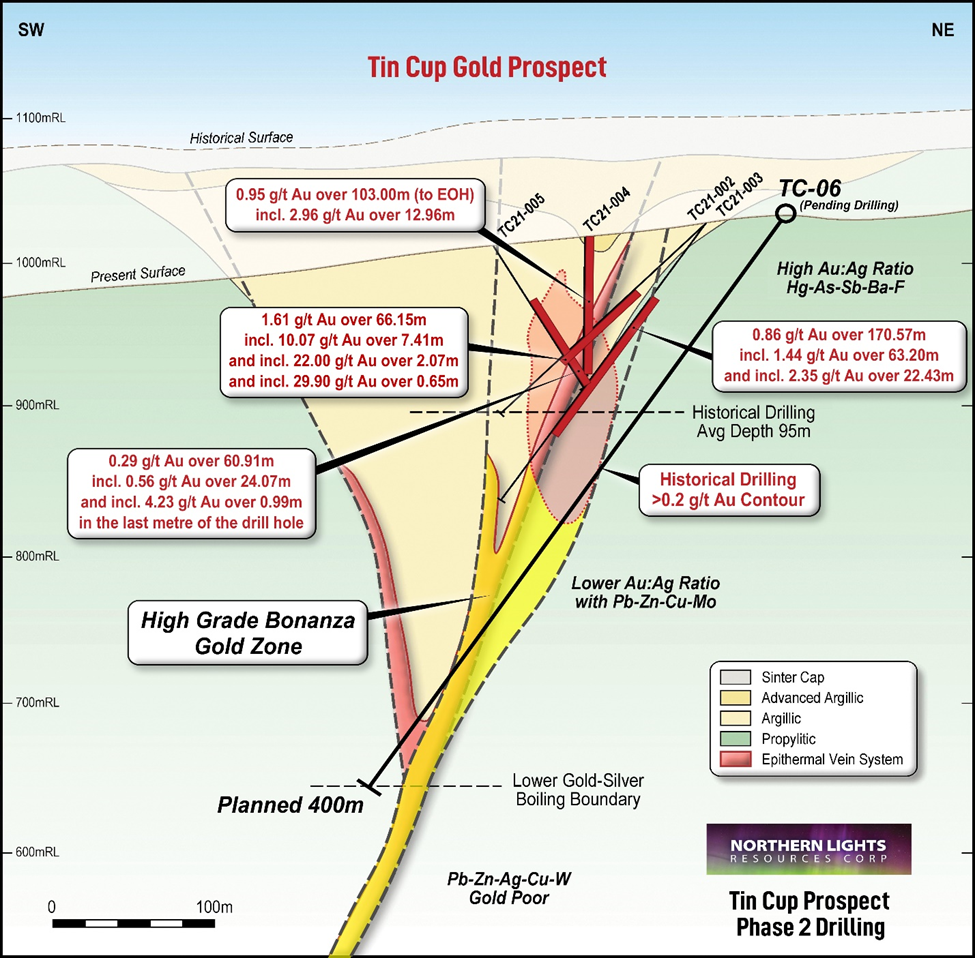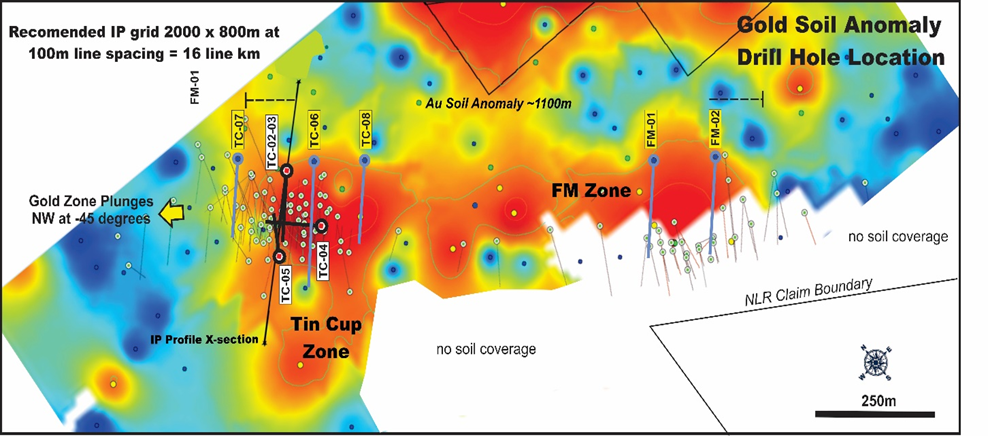Projects
Secret Pass Gold Project
Completion of Phase 1 Exploration & Drilling on Tin Cup & FM Zones
Phase 1 (2022) Exploration & Drilling Results – Tin Cup & FM Zones
Exploration Drilling Success
Northern Lights has successfully completed four diamond core drill holes at the Tin Cup deposit, totaling 610 meters. Each drill hole intersected zones of moderate to strong gold mineralization hosted within altered andesite. Gold occurs as disseminated to fracture-controlled, low-temperature mineralization, accompanied by moderate to high pyrite and hematite content. The associated alteration assemblage consists of sericite, quartz, chlorite, and carbonate.
Brecciated and gouge-filled fault zones, encountered in multiple drill holes, contain disseminated pyrite, reinforcing the structural controls on mineralization. Gold mineralization at Tin Cup is spatially associated with the northwest-trending Frisco Mine Fault, occurring within andesite host rock and along the margins of rhyolite dikes. Detailed drill hole locations and statistics are provided in Table 2, along with Figures 2, 3, and 4.
Historical RC Drilling & Resource Expansion Potential
Tin Cup’s gold mineralization remains open at depth, with historical reverse circulation (RC) drilling from the 1980s predominantly limited to an average depth of 95 meters. The objective of this initial diamond drill program was to validate previous RC drilling results and enhance geological understanding of the deposit’s mineralization style.
The mineralized zone extends approximately 245 meters along strike and has been drill-indicated to a depth of 180 meters, with significant expansion potential. High-grade gold mineralization (>10 g/t Au) is concentrated in narrow, sub-vertical structures within broader mineralized zones reaching up to 86 meters in width. The mineralization plunges northwest at a 50-degree angle. Historical drilling indicates variable surface oxidation, extending to a maximum depth of 120 meters. A summary of key historical drill intersections is provided in Table 1.
With these results, Northern Lights continues to advance its exploration strategy, targeting resource expansion and further delineation of high-grade gold zones at Tin Cup.
Table 1 - Selected Historic Drill Results at Tin Cup Zone
Hole No. | Year | Type | Depth (m) | Interval (m) | Width (m) | Au g/t |
TC-01 | 1984 | RC | 52 | 22.9-30.5 | 7.6 | 7.6 |
|
|
|
| 21.2-51.5 | 30.3 | 2.9 |
TC-10 | 1985 | RC | 176 | 89.9-121.9 | 32 | 13.6 |
|
|
|
| including | 1.5 | 40.4 |
|
|
|
| including | 12.2 | 20.8 |
TC-15 | 1985 | RC | 146 | 111.2-115.8 | 4.6 | 13.1 |
TC-30 | 1986 | RC | 150 | 63.3-150 | 86.7 | 4.1 |
including | 9.1 | 17.7 |
|
|
|
|
TC-32 | 1986 | RC | 90 | 18.8-69.7 | 50.9 | 2.7 |
TC-11 | 1987 | RC | 90.9 | 46.9-90.9 | 44 | 2.8 |
TC-14 | 1986 | RC | 121 | 90.9-121.9 | 31 | 5.8 |
Note: These results are historical in nature and a Qualified Person has not done sufficient work to verify these previous drilling results. Previously released on October 28, 2020.
Geophysical Correlation with Drill Results
Figure 1 illustrates the recent drilling results in relation to the historical Induced Polarization (IP) survey conducted by Santa Fe in 1986. This survey, with a maximum depth penetration of approximately 200 meters, identified a well-defined chargeability high that dips steeply to the east.
Drill results confirm a strong correlation between gold mineralization and this chargeability anomaly, which is associated with fracture-controlled pyrite observed throughout the mineralized zone. These findings reinforce the effectiveness of IP geophysics as an exploration tool at Tin Cup and suggest further potential for mineralization at depth beyond the limits of the historic survey.
Northern Lights continues to leverage modern exploration techniques to expand the known mineralized footprint and unlock additional resource potential.

Figure 1: Historical IP Chargeability Profile and Significant Gold Intersections
This image is the historic IP Chargeability Profile with recent drilling overlay.
Exploration Drilling Results – 2021 & 2022
Table 2: Tin Cup Phase 1 Drill Holes
Hole No. | Location | Azimuth (o) | Dip (o) | Length (m) | Significant Intersections |
TC21-01 | Tin Cup | - | - | - | Abandoned |
TC21-02 | Tin Cup | 220 | -45 | 175 |
|
TC21-03 | Tin Cup | 220 | -55 | 230 |
|
TC21-04 | Tin Cup | 310 | -50 | 103* |
|
TC21-05 | Tin Cup | 040 | -60 | 102* |
|
Total Drilling Completed | 610 |
| |||
Note: all intersections represent downhole widths as insufficient information is available to calculate true widths.
*Drill hole TC21-04 assay of .0.95g/t over103.00m, the entire length of thhe drill hole from collar to hole bottom
*Drill holes TC21-04 and TC21-05 were terminated early due to technical difficulties.

Figure 2: Tin Cup Drilling - Plan View

Figure 3: Tin Cup Drilling Cross Section and Geological Model
Pre-Drilling Exploration Strategy
Ahead of the second phase of drilling, Northern Lights is set to conduct a deep-penetrating Induced Polarization (IP) survey across the Tin Cup and FM zones. This survey, designed to explore depths of approximately 400 meters, will play a crucial role in refining existing drill targets and identifying new high-chargeability zones along strike and at depth.
As shown in Figure 4, the IP survey will cover the significant gold anomaly identified during the 2021 soil sampling program. This anomaly extends approximately 1,100 meters in length and up to 400 meters in width, highlighting a prospective corridor for further exploration.
By integrating modern geophysical data with historical drilling results, Northern Lights aims to optimize target generation and enhance the potential for further high-grade gold discoveries in the upcoming drill phase.

Figure 4: Drill Locations and Gold Soil Anomalies
Phase 2 Exploration Drilling: Expanding the Secret Pass Project
Building on the success of the initial drill program, Northern Lights is advancing its exploration efforts at the Secret Pass Project with a Phase 2 drilling program. This phase will include three additional drill holes at Tin Cup and two drill holes at the FM Zone, located approximately 500 meters east of Tin Cup. All five proposed drill holes are fully permitted (see Table 3 below), with their locations illustrated in Figure 4.
Targeting Depth Extensions and Strike Continuity
The three new holes at Tin Cup are designed to test the down-plunge extension of gold mineralization:
- TC21-06: Planned to a depth of 400 meters at a 55-degree dip, this hole will investigate deeper mineralization potential.
- TC22-07 & TC22-08: These holes will explore gold mineralization continuity along strike.
Drilling at Tin Cup aims to evaluate the potential for an epithermal quartz vein system, drawing geological comparisons to the Oatman District, known for its high-grade gold mineralization. The program will test both the upper broad zone of stockwork veining and the potential for deeper, high-grade ‘bonanza’ veins.
Advancing Exploration at the FM Zone
At the FM Zone, two planned drill holes will target near-vertical mineralized structures associated with the FM Fault Zone, a structural setting similar to Tin Cup. These holes will test gold-bearing structures at depth, refining the understanding of mineralization controls within the broader Secret Pass Project.
With these exploration initiatives, Northern Lights continues to unlock the resource potential at Secret Pass, leveraging modern drilling and geophysical techniques to expand and delineate high-grade gold mineralization.
Table 3: Tin Cup Planned Phase 2 Drill Holes
Hole No. | Location | Azimuth (o) | Dip (o) | Length (m) |
|
TC22-06 | Tin Cup | 220 | -65 | 400 | Fully Permitted – Pending Drilling |
TC22-07 | Tin Cup | 250 | -50 | 250 | Fully Permitted – Pending Drilling |
TC22-08 | Tin Cup | 200 | -50 | 150 | Fully Permitted – Pending Drilling |
FM22-01 | FM Zone | 220 | -50 | 150 | Fully Permitted – Pending Drilling |
FM22-02 | FM Zone | 220 | -50 | 150 | Fully Permitted – Pending Drilling |
Total Completed and Planned | 1,100 |
| |||
